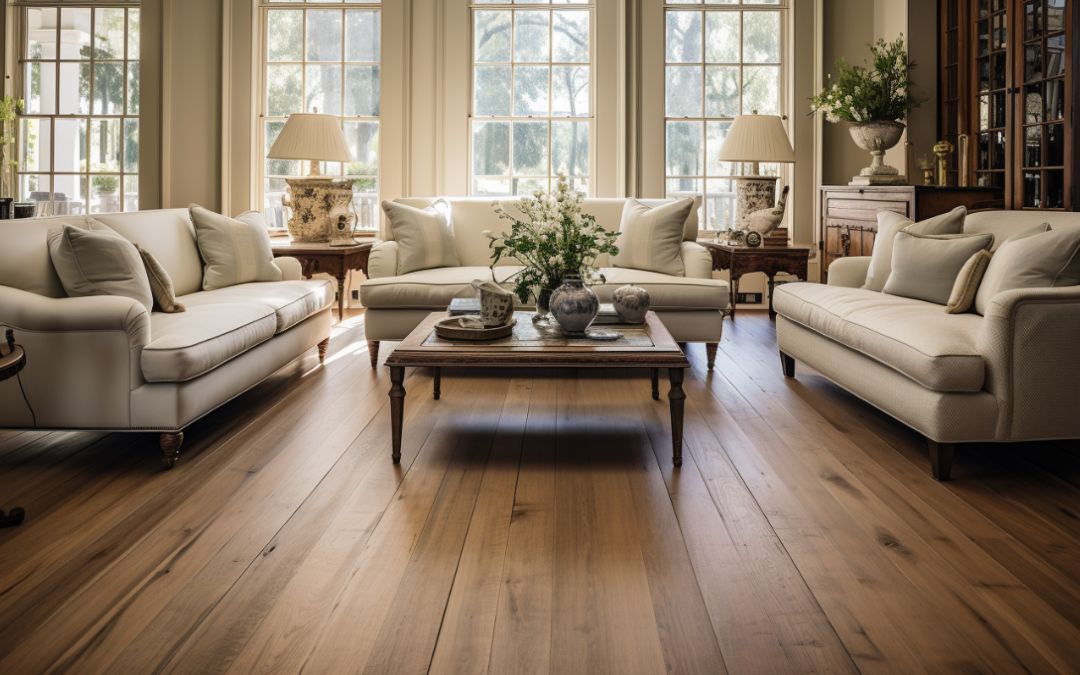Breathing New Life into Your Floors: The Magic of Hardwood Cleaning
Anyone who owns hardwood flooring knows that it is an investment that requires tender loving care to keep it looking beautiful without sacrificing any of its natural charm. To help ensure any hardwood floor maintains its beauty, this article will discuss the science behind effective hardwood cleaning, the aesthetics of keeping hardwood spotless, the benefits of DIY versus professional hardwood cleaning methods, and conclude with the importance of post-cleaning hardwood care and sustainability tips.
The Beauty of Clean Hardwood: More than Just Aesthetics
The beauty of clean hardwood flooring is more than skin deep. Not only does it add an extra level of sophistication and harmony to a room, but clean hardwood floors also provide a great deal of utility. Aesthetics aside, clean hardwood floors are extremely easy to maintain, and will last a lifetime when properly cared for.
Moreover, because of its longevity, hardwood floors require far less replacement than other flooring options like carpet, linoleum, and laminate. Similarly, hardwood floors are an excellent insulator, providing a resilient barrier between the surface and the under-flooring. This preserves energy within the room, resulting in lower energy bills.
On the other hand, potential homeowners should be aware that hardwood floors require a little extra care. A regular schedule of sweeping and vacuuming should be maintained to keep the surface clean and free of any dust, dirt, or debris which could scratch the finish. Furthermore, chairs and furniture should be outfitted with felt furniture coasters or padding to avoid surface damage. Hardwood floors are highly customizable. Homeowners can choose from a wide variety of grain patterns, stains, and sealants to create a look that is unique to them. Similarly, they can be refinished or re-coated periodically to freshen up the design.
For instance, those seeking a more vintage look can place an area rug over the floor to create a vintage vibe. As a result, they can easily transition between contemporary to traditional aesthetics without having to reinvest in new flooring.
Hardwood flooring not only offers unparalleled beauty, but also an incomparable range of versatility. Luxurious and dependable, hardwood flooring has become an increasingly popular option, and for good reason. It is the perfect choice for anyone wanting to create a warm and inviting atmosphere in their home.
The Science Behind Effective Hardwood Cleaning
The Science Behind Effective Hardwood Cleaning is complex and multifaceted. Hardwood surfaces, such as furniture, flooring and countertops, are porous materials and, as such, benefit from periodic cleaning. However, not all cleaning techniques are equal; some can be damaging and can strip away the hardwood’s protective finish. To effectively clean hardwood and achieve optimal results, it is important to understand the science behind the method.
Firstly, the use of detergents helps lift and remove dirt, debris, and other unpleasant odors from the hardwood surface. These detergents are typically composed of molecules that can penetrate the surface of the material, surround dirt and debris, and then lift them off with water. In addition, using a soft cloth or sponge helps avoid any further damage and will not scratch the surface of the wood.
Secondly, understanding the type of hardwood surface being cleaned is key. Even the most delicate of hardwoods can be suited to a routine cleaning. For instance, unfinished woods typically need to be cleaned with a soft cloth and a very mild soap to preserve the natural oils. Whereas, sealed and polyurethane-treated woods require more abrasive cleaning steps, such as using a commercial hardwood floor cleaner or a spray-on product specifically designed for hardwood.
Thirdly, understanding the quality of the protective finish is also important. The type of finish on hardwood is reactive to a certain type of cleaning; therefore, if the wrong product is used, it can penetrate that finish and damage it, causing it to become dark and cloudy. However, if the appropriate product is used, it will only affect the dirt and any debris on the surface, leaving that finish intact and looking great for years to come.
Finally, an important science-based step to note for anyone cleaning hardwood is to remember to avoid the use of water-based cleaners and excessive water when cleaning. This is because water is absorbed by the material and can lead to warping or dark spots. Moreover, some steam mops are advised against because the steam created during operation can actually be too hot and damage the wood’s finish.
Consequently, these simple steps ensure that the hardwood surface is cleaned without needing to replace the protective finish. Following the science-based expertise can help keep hardwood looking its best while also adding a lifetime of useful value to the piece.
DIY vs. Professional Hardwood Cleaning: Which Route to Take?
When it comes to hardwood floor maintenance, property owners must decide whether it’s worth tackling Do-It-Yourself (DIY) or hiring a professional. Each approach has its benefits and drawbacks, but it’s important to weigh these carefully to determine the best option for one’s individual needs.
On one hand, DIY maintenance tends to be much less expensive than professional services. Furthermore, some people find that tackling the job themselves is extremely satisfying. If you’re capable of following instructions, this can be an effective way to maintain one’s hardwood floors. It’s important to consider that DIY maintenance can also be much more time-consuming. As a result, a busy and time-pressed homeowner may be better off hiring a professional with appropriate expertise and skills. Additionally, a professional has access to specialized equipment and the right products to get the job done safely and effectively.
In contrast to DIY maintenance, professional cleaning for hardwood floors involves hiring a vetted service provider with the right credentials. Normally, it’s a good idea to research providers before making a commitment. Usually, a professional will have more experience with a variety of floor surface materials, understand the possible environmental hazards, and know the essential safe handling practices. A professional like ACE should use safe and good quality cleaning ingredients. That means that the product chosen should be effective but gentle enough to allow for long-term use. It will generally be free from harmful chemicals and biodegradable, able to be safely disposed of or recycled.
In summary, whether one opts for DIY or professional hardwood cleaning will depend on needs and preferences. However, there’s no doubt that each approach has its benefits and drawbacks. It’s simply important to carefully consider the pros and cons before making the best decision for one’s individual situation.
Preserving the Longevity: Post-Cleaning Hardwood Care Tips
Once hardwood flooring is properly installed and cleaned, it is important to take measures to ensure its lasting beauty. Firstly, it is essential to regularly dust or vacuum the floor to remove debris and dirt. Next, employ specialized cleaning products that are specific to hardwood flooring to avoid damage that could be caused by using a generic product. Furthermore, mats and area rugs should be placed at entry points to reduce the amount of dirt and moisture that will be brought onto the floor while clearing the area of furniture can allow a thorough sweep or mop of the entire flooring.
In addition, it is highly recommended to apply wood floor refinishing or sealant on a regular basis, approximately every two to three years. However, extremely worn or damaged floors may benefit from an additional application of refinishing or sealant. Keeping this hardwood flooring clean and maintained on a regular basis can prevent scratches and marks from accumulating while also ensuring the longevity and look of the floors.
Finally, spills and messes should be removed immediately to prevent them from staining the floor. Moreover, avoid products such as soap or any commercial cleaning product that does not specifically list hardwood floor compatible on the label. Similarly, it is important to periodically check the floor for signs of damage or wear, as the floor will naturally deteriorate over time and require periodic maintenance. As a result, taking the right steps and measures to preserve the longevity of hardwood flooring can help keep the floor looking its best for many years to come. Contact ACE today for your hardwood cleaning!
Key Takeaways
It can be seen that the beauty of clean hardwood can offer more than aesthetics, as it is a sign of effective cleaning and maintenance practices. The science of effective hardwood cleaning is complex and varied, requiring the use of various products, cleaning methods, and equipment. When it comes to the decision of DIY or professional hardwood cleaning, the route chosen comes down to personal preference and the confidence of the consumer in their ability to clean properly. Lastly, after the cleaning is completed, it is important to practice post-cleaning Hardwood care tips in order to help preserve the longevity and beauty of the clean hardwood. With these considerations, both homeowners and experienced flooring professionals can benefit from understanding and adhering to the necessary hardwood cleaning and maintenance practices.
Frequently Asked Questions
How often should hardwood floors be professionally cleaned?
Hardwood floors should be professionally cleaned and polished every six months to two years. In between professional cleanings, it is recommended to routinely sweep, dust mop, and/or spot clean the floors as needed.
Can I use water and vinegar to clean my hardwood floors?
Yes, you can use a mixture of water and vinegar to clean your hardwood floors. However, it is important to make sure the solution is diluted properly with water, as too much vinegar can damage the wood. Additionally, use a damp mop to clean the floor and make sure to dry it immediately after to avoid damage.
Why do my hardwood floors look dull even after cleaning?
There can be several reasons why your hardwood floors look dull even after cleaning. The most common reason is if you used an abrasive cleaner that has stripped the protective coating off your floor, leaving it looking dull and discolored. Other causes could include an inconsistent application of a sealant or wax, low-quality cleaning products, inadequate and improper maintenance, or surface damage that has resulted in the loss of the floor’s protective finish. To bring back the shine to your hardwood floors, you should use floor cleaner designed specifically for hardwood floors that does not contain abrasive ingredients. You may also need to reapply a sealant or wax, depending on the floor’s condition.
Is it safe to steam clean hardwood floors?
Yes, it is safe to steam clean hardwood floors as long as the steam cleaner is used in accordance with the manufacturer’s instructions. Before using a steam cleaner, it is always best to check with the manufacturer’s manual to check the suitability of the steam cleaner for hardwood floors, as some steam cleaners may not be suitable for use on hardwood floors.

